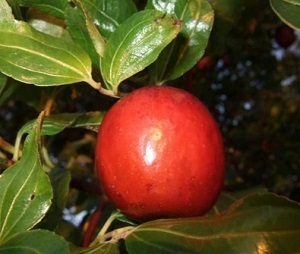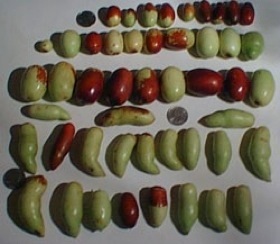From Eat the Weeds
and other things, too
by Green Deane
Jujube Tree

Jujube tree fruit
Ziziphus zizyphys: The Misspelled Jujube
If you don’t find the Jujube tree, it will find you. The
Jujube is covered with long, sharp thorns. They hunt you down. They daw
blood. They hurt. If I get within a yard of a Jujube Tree I somehow get
skewered. Badly. Continuously. Inevitably.
Another little fact
you are never told about the tree is if you plant it then move it the
old roots, and the new roots where you plant it, will send up young
shoots annually seemingly forever. You end up with a multitude of
shin-high saplings puncturing your ankles. The Jujube is a pain but its
fruit is tasty and versatile.

Jujube fruit varies in shape
In
the Buckthorn Family, the Jujube is distributed in warm-temperate and
subtropical regions around the word. In the US it is naturalized in
southern states from Georgia to California, excepting Louisiana and New
Mexico but including Utah. Throughout the genus the leaves are quite
regular and distinct. They alternate, are finely toothed, and have
three prominent basal veins (coming from where the leaf meets the
stem.) They also usually have two spines at the base of the leaf. The
small flowers are chartruese (yellow-green) with five petals. The fruit
is a drupe, edible, that can range from green when unripe to yellow to
brown to red or black. When green it tastes like and apple and has the
texture of an apple. When ripe it is closer to a date in flavor and
texture. A single stone contains two black seeds which are not eaten.

Fruit is often sold dried
The
Jujube has been cultivated for over 4,000 years and there are some 400
cultivars, that is, specifically bred varieties. Native to China
— it’s been called the Chinese date and Indian date —
Jujubes got to southern Europe around the time of the Romans and to the
United States in 1837. Starting in 1908 high-quality cultivars were
also introduced, initially in Tifton, Georgia by the USDA.
The
genus has an interesting naming history. It was originally Rhammus
zizyphys. But 15 years later it was put into a new genus but misspelled
as Ziziphus. Naming rules prohibit calling the genus and the species by
the same name. But since one was misspelled the name uniquely
stands as Ziziphus zizyphus. There are many species including Ziziphus
jujuba, where the common name comes from. It is said ZIZ-ih-fuss
jew-JEW-buh (or SIZE-eh-fus.)
Ziziphus comes from two different
words. Zizafun was the Persian word for the Z. lotus tree
(Jujube.) Phus is latinized Greek meaning “bearing.”
So Ziziphus in English means Jujube bearing. Jujube can be said
two ways: JEW-jewb or JUJU-bee.
While Jujubes can be eaten out
of hand thery’re made into a wine, are cooked, and often are
de-stoned and dried. A leaf extract, Ziziphin, alters taste perceptions
of sugar in humans. It makes sweet things taste not sweet. Think of it
as the anti-sweet. See recipes below. There are also numerous medicinal
uses as well.
Jujube Cake
1 cup sugar
1/2 cup butter
2 cups dried, minced jujube
1 cup water
Bring these to a boil then set aside to cool
2 cups wheat flour
1 teaspoon soda
1/2 teaspoon salt
Sift these together then add to the above mixture. Bake at 325° F
Candied Jujubes
Wash
about three pounds dried jujubes; drain and prick each several times
with a fork. In a kettle bring to a boil 5 cups water, 5-1/2 cups
sugar, and 1 tablespoon corn starch. Add the jujubes and simmer,
uncovered, stirring occasionally, for 30 minutes. Cool, cover, and
chill overnight. The next day bring syrup and jujubes to a boil and
simmer, uncovered, 30 minutes. With a slotted spoon lift jujubes from
syrup and place slightly apart on rimmed pans. Dry in oven, or in sun
for about 2 to 3 days. Check fruit frequently and turn fruit
occasionally until the jujubes are like dry dates.
Jujube Syrup
Boil
syrup remaining from the Candied Jujubes, uncovered, until reduced to
about 2 cups. Use over pancakes and waffles. Store in the refrigerator.
Other uses: Substitute the dried jujube wherever recipes call for
raisins or dates.
Green Deane’s “Itemized” Plant Profile
Identification:
A small, deciduous tree to 40 feet usually with single trunk and
rounded crown. Waxy leaves are simple and alternate, green on top,
whitish green on bottom, in two rows on zigzaging twigs. They have
hairy stems, very fine teeth, and three prominent veins. The
brown bark has vertical fissures. And while I say the tree has thorns
they are rightly spiny stipules. Bottom line: At each leaf you will
find a half inch to one inch long very sharp thorn. Beware!
Time of year: Fruits late in to winter depending upon climate. The fruit do not all ripen at the same time.
Environment:
Likes sunny locations and sandy soil. Like regular watering but is
drought tolerant, hardy down to -25F but needs around 200 chill hours
to fruit if planted in a warm climate. It does not like to grow in a
container.
Method of preparation:
Fruits are eaten raw, candied, made into drinks, and dried. They can
eaten unripe, ripe and can be left to dry on the tree. The ripe
fruit is very high in vitamin C.
Green Deane's Disclaimer
Information
contained on this website is strictly and categorically intended as a
reference to be used in conjunction with experts in your area. Foraging
should never begin without the guidance and approval of a local plant
specialist. The providers of this website accept no liability for the
use or misuse of information contained in this website.
Back to
Chinese Date Page
|
|


